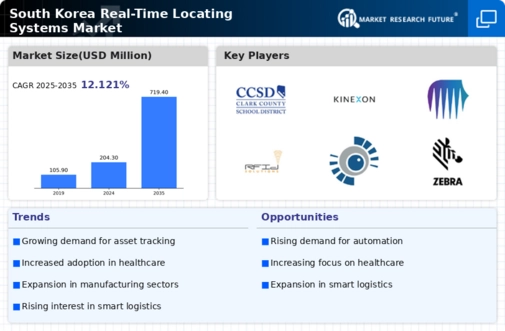Integration with IoT Solutions
The convergence of real time-locating-systems with Internet of Things (IoT) technologies is emerging as a key driver in the market. In South Korea, the proliferation of IoT devices is facilitating the seamless integration of RTLS into various applications, from smart buildings to supply chain management. This integration allows for enhanced data collection and analysis, leading to improved operational efficiencies. The real time-locating-systems market is expected to benefit from this trend, with projections suggesting a growth rate of around 22% as businesses seek to leverage IoT capabilities for better asset management and tracking. The synergy between RTLS and IoT is likely to create new opportunities for innovation and service delivery.
Growing Demand for Asset Tracking
The increasing need for asset tracking solutions is a significant driver for the real time-locating-systems market. In South Korea, businesses are recognizing the value of real-time visibility into their assets, which can lead to enhanced operational efficiency and reduced losses. The market for asset tracking is projected to grow substantially, with estimates suggesting a potential increase of 15% in the next few years. Companies are investing in RTLS to monitor inventory levels, manage equipment, and optimize resource allocation. This trend is particularly evident in industries such as manufacturing and logistics, where the ability to track assets in real-time can lead to significant cost savings and improved service delivery.
Government Initiatives and Support
Government initiatives aimed at promoting technological innovation are playing a crucial role in the growth of the real time-locating-systems market. In South Korea, various policies and funding programs are being introduced to support the development and adoption of advanced locating technologies. These initiatives are designed to enhance competitiveness and drive economic growth, particularly in sectors such as logistics, healthcare, and manufacturing. The market is likely to see increased investment as a result of these supportive measures, with estimates indicating a potential growth of 25% in the adoption of RTLS solutions over the next few years. This government backing is expected to foster a conducive environment for innovation and collaboration among industry stakeholders.
Technological Advancements in RTLS
The real time-locating systems market is experiencing a surge due to rapid technological advancements. Innovations in wireless communication technologies, such as Bluetooth Low Energy (BLE) and Ultra-Wideband (UWB), are enhancing the accuracy and efficiency of locating systems. In South Korea, the integration of these technologies is expected to drive market growth, with projections indicating a compound annual growth rate (CAGR) of approximately 20% over the next five years. Furthermore, the development of advanced algorithms for data processing and analytics is enabling businesses to leverage real-time data for improved decision-making. This technological evolution not only enhances operational efficiency but also reduces costs, making RTLS solutions more appealing across various sectors, including retail and manufacturing.
Increased Focus on Safety and Security
Safety and security concerns are driving the adoption of real time-locating-systems in various sectors. In South Korea, organizations are increasingly implementing RTLS to enhance workplace safety and ensure compliance with regulations. The market is witnessing a notable shift towards solutions that provide real-time monitoring of personnel and assets, particularly in high-risk environments such as construction and healthcare. This focus on safety is likely to propel market growth, with estimates indicating a potential increase of 18% in demand for RTLS solutions over the next few years. By utilizing RTLS, companies can quickly respond to emergencies, track personnel locations, and ensure a safer working environment.


















Leave a Comment